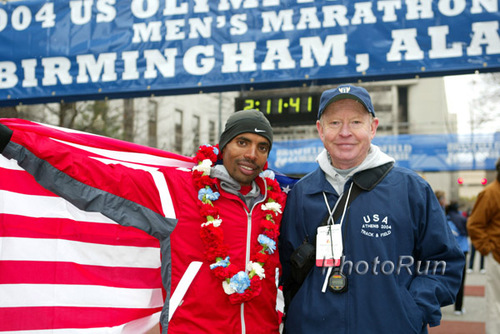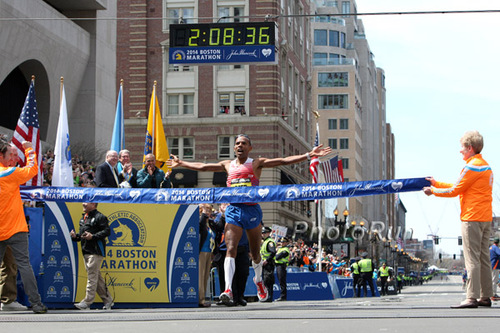Updated February 27, 2017.
City Slickers, the movie featuring Coach Bob Larsen, is now available for sale. We highly recommend the video! We worship the man! You can purchase or rent at https://www.amazon.com/City-Slickers-Cant-Stay-Me/dp/B06WV8MHJ3. Here is part one of Cathal Dennehy’s fine interview with Coach Bob Larsen.
An athlete and his coach, US Olympic Trials 2004,
photo by PhotoRun.net
As the man who has guided Meb Keflezighi for the duration of his senior career – and one of the most instrumental figureheads in the renaissance of American distance running – Bob Larsen is a man with an enviable wealth of wisdom when it comes to coaching.
Currently, Larsen coaches just Keflezighi, though the number of athletes he has developed from high school to college to elite levels down through the years is colossal. His coaching has spanned all levels of the sport, from his days at Grossmont College in the 1960s to a successful tenure as UCLA Head Coach in the ’80s, and more recently working at the Mammoth Track Club – and in 2005 his achievements earned him the prestigious Bill Bowerman award from the National Distance Running Hall of Fame.
Larsen is in New York this weekend to follow his star pupil Keflzighi on his attempt to regain the New York City Marathon title, and he spoke to Cathal Dennehy for RunBlogRun yesterday and allowed us to pick his brains on a range of topics. Here is the first of a two-part discussion.
Meb wins Boston, photo by PhotoRun.net
Cathal Dennehy: How did you develop your coaching philosophy?
Bob Larsen: When I was running, we used to just train to the point where we got injured. We didn’t know enough to back off. We couldn’t stay healthy, we were beating ourselves up, and I knew there had to be something better than that, so I started experimenting when I was assistant coaching on athletes at my college.
We did longer threshold runs, and I found how successful those were. We got really good results. I knew we were on to something. At each level, high school and college, our teams started to dominate, but the true test was if we could keep them in the sport.
CD: How did you go about developing distance runners who can compete with the East Africans?
BL: My thoughts were: the East Africans had been running since they were really young, and had put in so many more miles when they were teenagers, than Americans. Meb came to America as an eight-year-old, but rode the bus to school, so he was the perfect test. Him and Deena Kastor were the perfect subjects to be the leaders of our group, because they weren’t head and shoulders over other Americans and if we did something that separated them, we knew we could inspire others. Foremost in my mind: American runners had to get to altitude.
CD: And that wasn’t the done thing in American distance running at the time?
BL: In 2000, there was almost no Americans training at altitude, besides a few schools. Part of the negativity about altitude was that it didn’t help unless you were racing at altitude. Almost every medal at worlds or Olympic Games is won by athletes either living or training at altitude, so in 2003 we got the chance to do it right.
Joe vigil was hands-on with Deena, me with Meb. We put it together and had a great Olympics, and Meb and Deena did something we haven’t done in 20 and 28 years, and now, between them, they’ve won 4 of the major 5 original marathons in the world.
CD: How did they train that was differently to the way it was done in the 90s?
Joe Vigil, like me, is an exponent of threshold training. We did a little higher mileage than Americans were used to. In the ’90s there was a move away from higher volume in favour of intervals, and the same happened in American swimming, and all of a sudden we weren’t among the best in the world. It was the lowest point for American distance running.
CD: What went so wrong in the 90s that led to that drop in standards?
BL: In the 70s and 80s, the volume approach was working, but we lost all that because guys started ratcheting up the miles so much, into the 170s and 200-mile range, and guys started getting hurt, and it kind of gave distance running a bad name. Seb Coe and his father publicised the fact intensity was so important, but they tended to leave out the fact that George Gandy was training Sebastian Coe in the fall and winter. They were running 80 miles a week through the hills, and he was very strong when his father started training him for track. A lot was lost in translation when Peter Coe came over here and talked about the intensity he trained Coe with.
In the 2000s, we set out to get the volume up again. Interval training is important but don’t put the cart in front of the horse. Get them fit first, get the base, then the threshold, then you move to the intervals. It’s worked. Now, in one race alone, the Arcadia high school meet, you have 18 guys going under 9 minutes for 3,200m. In the 1990s we didn’t have a single American in high school going under it in certain years.
CD: If you can stay healthy, is more mileage generally better?
BL: All of us get in trouble when we think of the more, the better. I always remind myself to get the most out of the least amount of work. I’ve been guilty of pushing beyond that line, though.
CD: Is it possible to reach an absolute peak as a distance runner without training at altitude?
BL: I think Meb could have got to 27:13 (for 10,000 meters) without training at altitude, but it would have taken him longer to get there. In 2001, we did three weeks at altitude with Meb, then one week down and he ran the American record; that got everybody’s attention. We don’t try to convince everyone to go to altitude. There are times when an athlete can’t. You can run very fast based at sea level. Just look at the Irish runners over the years, but the bar keeps being raised, and to be able to do what these guys are doing is tough without altitude training.
CD: How long did it take to find what works for Meb and how much has his training evolved over the years?
BL: When he came to UCLA, I felt fairly early on he might have a post-collegiate career. I was head track coach. I was relying mostly on walk-on kids for distance running, so we gave the scholarships to sprinters and throwers because they can score lots of points. It was a blessing in disguise, because if he was at another school he’d have won more NCAA titles, but this way I could bring him along slower, keep him healthy and growing all along that time.
His first year at UCLA, he hit 60 miles a week, but I wasn’t putting 80 or 90 on him like some schools do. I’ve had athletes who were so durable, but with Meb I could never get over 110. With Meb I suspected early on it was better to bump him up slowly.
CD: How do you recognise that in an athlete?
BL: With Meb, it was his background. If Meb pushed too much, he’d come down with a minor injury that was hard to shake off, and we were always looking post-collegiately. Many athletes were used up in college, but I don’t blame the coaches. They’re paid to get results in college, not at Olympic Games. So many guys who beat Meb in college traded success then for the long-term. He’s the last man standing, by far.
You ask yourself what he did differently. Part of it is his willingness to do drills, strength work, nutrition, and he’s stayed motivated all these years, but I think not overdoing it at any one time was key.
In Part two, Larsen goes into more detail about how he turned Meb from a good collegiate athlete into one of the world’s great marathon runners, and explains more of what he’s learned from decades of coaching at all levels of the sport.
Author

Larry Eder has had a 52-year involvement in the sport of athletics. Larry has experienced the sport as an athlete, coach, magazine publisher, and now, journalist and blogger. His first article, on Don Bowden, America's first sub-4 minute miler, was published in RW in 1983. Larry has published several magazines on athletics, from American Athletics to the U.S. version of Spikes magazine. He currently manages the content and marketing development of the RunningNetwork, The Shoe Addicts, and RunBlogRun. Of RunBlogRun, his daily pilgrimage with the sport, Larry says: "I have to admit, I love traveling to far away meets, writing about the sport I love, and the athletes I respect, for my readers at runblogrun.com, the most of anything I have ever done, except, maybe running itself." Also does some updates for BBC Sports at key events, which he truly enjoys. Theme song: Greg Allman, " I'm no Angel."
View all posts




















